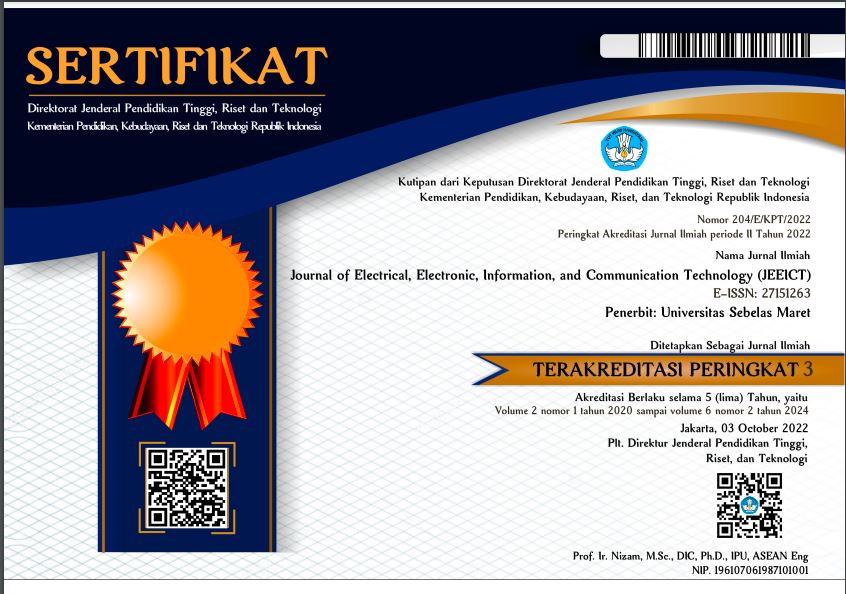Design of Monitoring and Separating Dustbin System using Internet of Things
Abstract
The growing population is causing a big problem in terms of waste. Garbage sorting efforts need to be made, especially the separation between organic and non-organic garbage, so that non-organic garbage that can still be recycled is not contaminated by organic garbage containing water and oil. Moreover, it requires swift handling of trash bins that are full so that trash does not accumulate and become an epidemic. For that we need innovation in the form of technology that is able to overcome these problems. This paper is designed IoT-based garbage for monitoring and separating dustbin. The design of garbage was made using Arduino UNO as a microcontroller that can monitor and sort garbage automatically. There are 2 stages in the garbage sorting process. The first stage is the metal and non-metal separation, and then the second stage is the organic and non-organic stages. When the trash is full, the trash can lid will be locked and then the system will send a notification to the garbage manager regarding the location/position of the trash and the weight of the trash. This research method includes 4 stages such as analysis of needs and working methods, design of hardware and software design, implementation, and finally testing of the design.
Keywords— garbage, waste management, garbage sorting, separting dustbin, internet of things
Full Text:
PDFReferences
Kementrian Lingkungan Hidup dan Kehutanan RI : Gerakan Nasional Pilah Sampah Dari Rumah Resmi Diluncurkan. 2019. https://www.menlhk.go.id/site/single_post/2379
IPB University: Indonesia is the Second Largest Plastic Waste Contributor in the World. 2018. https://ipb.ac.id/news/index/2018/10/indonesia-is-the-second-largest-plastic-waste-contributor-in-the-world/65b58e2ccb3ffe42cd0470ea3624b018
Hari Bhakta Sharma, Kumar Raja Vanapalli. Challenges, opportunities, and innovations for effective solid waste management during and post COVID-19 pandemic. 2020. https://www.ncbi.nlm.nih.gov/pmc/articles/PMC7362850/
Dedi Setiawan 2018 Rancang Bangun Alat Pembuka dan Penutup Tong Sampah Otomatis Berbasis Mikrokontroler. http://is.its.ac.id/pubs/oajis/index.php/home/detail/ 1289/RANCANG-BANGUNALAT-PEMBUKA-DAN-PENUTUP-TONG-SAMPAH-OTOMATIS-BERBASIS-MIKROKONTROLER
Faisal I P 2019 Perancangan Prototype Alat Pemilah Sampah Otomatis .http://jurnal.umsu.ac.id/index.php/RELE/article/view/3645.
Bioenable 2019 Smart Bins for Smart City. https://www.bioenabletech.com/smart-bins-for-smart-city.html
Sensoneo: Smart Waste Management System 2019. https://sensoneo.com/press/
Nugroho Panji, 2013. Panduan Membuat Kompos Cair. Jakarta: Pustaka baru Press.
Yudhanto, Yudha.2015. Apa itu IoT (Internet of Thing). Surakarta.
Aduino Uno Rev 3. https://store.arduino.cc/usa/arduino-uno-rev3
Apa itu modul esp 8266. https://www.nyebarilmu.com/apa-itu-modul-esp8266/.
Yi-Xin Guo, Cong Lai, Zhi-Biao Shao, Kai-Liang Xu, and Ting Li. 2019. Differencial Structure of Inductive Proximity Sensor.https://www.researchgate.net/publication/333065570_ Differential_Structure_of_Inductive_Proximity_Sensor
Rohman, Abdul and Ayub Subandi. 2017. Rancang Bangun Pemilahan Sampah Skala Kecil Berbasis Mikrokontroler Secara Otomatis. https://repository.unikom.ac.id/53739/
Capacitive Proximity Sensors Theory of Operation. 2018. http://www.softnoze.com/ downloads/Sensor%20Basics%203.pdf
What is an Ultrasonic Sensor. 2019. https://www.keyence.com/ss/products/sensor/ sensorbasics/ultrasonic/info/
IR Sensor.2015.https://www.electronicshub.org/ir-sensor/
Load Cell. 2017.https://www.omega.co.uk/prodinfo/load-cells.html
Servo Motor: types and working principle explained. 2018. https://engineering.eckovation.com/servo-motor-types-working-principle-explained/
Refbacks
- There are currently no refbacks.







